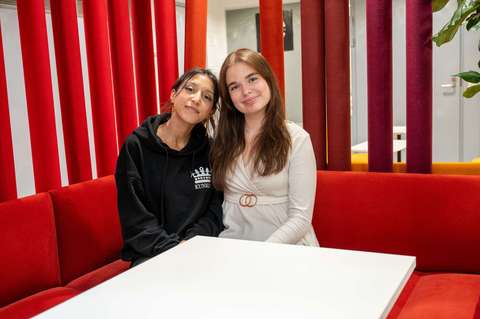Jana and Joanna from Kuninkaantien lukio: “You can simply be yourself here”
Jana Mozer and Joanna Kärnä are studying at the Kuninkaantien lukio upper secondary school. They both speak highly of the teachers and community spirit at the school. According to Jana and Joanna, even the dreaded test week is not as bad as it sounds.
Jana Mozer and Joanna Kärnä are studying at the Kuninkaantien lukio general upper secondary school. For Joanna, this is her second year, whereas Jana is already in her third and final year. For both, the choice of upper secondary school was influenced by the fact that Kuninkaantien lukio had a fairly high admissions grade average, which reflects the high quality of the school. Moreover, the good matriculation examination results achieved at Kuninkaantien lukio also affected the decision.
Joanna had heard many positive things in advance from her sister who studied at Kuninkaantie, and she also visited the school on presentation day to get a sense of the on-site atmosphere. The school prides itself on upholding a particular Kuninkaantie spirit. “You can be yourself here. There is less diversity and fewer people with an immigrant background here than in some other upper secondary schools, but there is no discrimination,” Jana says. According to Joanna and Jana, Kuninkaantien lukio is a community where the students do not have to fit into the same mold – everyone will find friends, and it is easy to get along with others.
Relaxed atmosphere in class
Jana's favourite school memory is the second-year students’ dance. “That whole day was the best thing ever. I didn't even mind waking up at 6:00. Everyone could dress up as much as they wanted to, and we all admired each others’ outfits,” Jana recalls. She recommends the second-year students’ dance to all upper secondary school students: "You do not want to miss it!"
For Joanna, the dance still lies ahead at the time of this interview, but she has already bought a dress for the party. “Although I was only a first-year student last year, I loved the second-year students’ dance day. I was one of the servers at the festive lunch organised for the dancers,” Joanna explains. At Kuninkaantien lukio, the dancers do not have named partners. This ensures that everyone gets a chance to dance.
In addition to the second-year students’ dance, Jana’s favourite thing in upper secondary school has been spending time with friends, both during and between lessons. Joanna confirms that the lessons are rather relaxed. “You don’t have to just sit quietly and listen,” Jana sums up. However, upper secondary school requires a more independent approach than comprehensive school, as no-one checks whether you have done your homework or not. For some, this may pose a challenge.
Both Jana and Joanna speak highly of the teachers at Kuninkaantien lukio. “Here, the teachers actually want you to get good grades,” Jana explains. Teachers start preparing the students for the matriculation examinations from the very beginning. Furthermore, they are nice, and you can stay and talk to them after lessons. “The teachers make the subjects interesting and bring them to live,” Jana and Joanna say.
Tests where harder in lower secondary school
One of Joanna’s favourite memories from upper secondary school so far is a physical education course which she is taking together with all her friends: “Our PE teacher, Tomppa, provides encouragement in all sports.” During the course, the students have tried out a variety of different ball games, such as floorball, basketball and volleyball. On the day of the interview, the class had been playing a game of Finnish baseball.
Rather surprisingly, Joanna also likes the test week: “The best part is when everyone gathers afterwards in the school cafeteria to talk about the test. The days are also shorter during the test week.” Jana admits that she used to stress over test weeks, but now she knows that as long as you have paid attention in class, the actual test week does not require any major effort. “It is up to you how hard the test week is going to be. If you want top grades in all subjects, the week can definitely be demanding. You have to choose what you want to focus on, and you should definitely focus on the subjects that you intend to take in the matriculation examinations,” Jana points out. However, she has actually changed her mind about the tests countless times. Jana feels that the exams in comprehensive school felt harder because they were scattered throughout the academic year.
Lifelong friendships are forged in upper secondary school
After upper secondary school, Jana wants to study at the Aalto University School of Business. She has no backup plan. If she does not get enough points to be admitted to Aalto University, she will take a gap year to improve her grades. Joanna, on the other hand, wants to study psychology in either Helsinki or Tampere, but “it’s almost as difficult to get in there as to medical school”.
Joanna encourages ninth-graders to choose an upper secondary school that seems to have a positive, collegial atmosphere – because the actual studying is pretty much the same everywhere. In turn, Jana urges ninth-graders to write down what they hear about different upper secondary schools, and make a list of the pros and cons. The school with the most pros is the one they should apply to. “Do not choose a school just because your friends go there. You will find a whole new group of friends in upper secondary school once the old cliques have been dissolved,” Jana says. Joanna agrees: "In upper secondary school, you get to forge new friendships that will last you a lifetime.”
